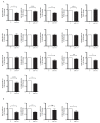High-Throughput Identification of MiR-145 Targets in Human Articular Chondrocytes
- PMID: 32403239
- PMCID: PMC7281014
- DOI: 10.3390/life10050058
High-Throughput Identification of MiR-145 Targets in Human Articular Chondrocytes
Abstract
MicroRNAs (miRNAs) play key roles in cartilage development and homeostasis and are dysregulated in osteoarthritis. MiR-145 modulation induces profound changes in the human articular chondrocyte (HAC) phenotype, partially through direct repression of SOX9. Since miRNAs can simultaneously silence multiple targets, we aimed to identify the whole targetome of miR-145 in HACs, critical if miR-145 is to be considered a target for cartilage repair. We performed RIP-seq (RNA-immunoprecipitation and high-throughput sequencing) of miRISC (miRNA-induced silencing complex) in HACs overexpressing miR-145 to identify miR-145 direct targets and used cWords to assess enrichment of miR-145 seed matches in the identified targets. Further validations were performed by RT-qPCR, Western immunoblot, and luciferase assays. MiR-145 affects the expression of over 350 genes and directly targets more than 50 mRNAs through the 3'UTR or, more commonly, the coding region. MiR-145 targets DUSP6, involved in cartilage organization and development, at the translational level. DUSP6 depletion leads to MMP13 upregulation, suggesting a contribution towards the effect of miR-145 on MMP13 expression. In conclusion, miR-145 directly targets several genes involved in the expression of the extracellular matrix and inflammation in primary chondrocytes. Thus, we propose miR-145 as an important regulator of chondrocyte function and a new target for cartilage repair.
Keywords: RNA-immunoprecipitation; cartilage; chondrocyte; miRNAs.
Conflict of interest statement
The authors declare no conflict of interest.
Figures






Similar articles
-
Derepression of MicroRNA-138 Contributes to Loss of the Human Articular Chondrocyte Phenotype.Arthritis Rheumatol. 2016 Feb;68(2):398-409. doi: 10.1002/art.39428. Arthritis Rheumatol. 2016. PMID: 26359943
-
Regulation of human chondrocyte function through direct inhibition of cartilage master regulator SOX9 by microRNA-145 (miRNA-145).J Biol Chem. 2012 Jan 6;287(2):916-24. doi: 10.1074/jbc.M111.302430. Epub 2011 Nov 18. J Biol Chem. 2012. PMID: 22102413 Free PMC article. Clinical Trial.
-
Silencing of microRNA-101 prevents IL-1β-induced extracellular matrix degradation in chondrocytes.Arthritis Res Ther. 2012 Dec 10;14(6):R268. doi: 10.1186/ar4114. Arthritis Res Ther. 2012. PMID: 23227940 Free PMC article.
-
Downregulation of miR-221-3p contributes to IL-1β-induced cartilage degradation by directly targeting the SDF1/CXCR4 signaling pathway.J Mol Med (Berl). 2017 Jun;95(6):615-627. doi: 10.1007/s00109-017-1516-6. Epub 2017 Feb 24. J Mol Med (Berl). 2017. PMID: 28236026
-
MicroRNA-27b targets CBFB to inhibit differentiation of human bone marrow mesenchymal stem cells into hypertrophic chondrocytes.Stem Cell Res Ther. 2020 Sep 11;11(1):392. doi: 10.1186/s13287-020-01909-y. Stem Cell Res Ther. 2020. PMID: 32917285 Free PMC article.
Cited by
-
Comprehensive Multi-omics and Mendelian Randomization Reveal the Key Role of Monocytes in Aging and Osteoarthritis.Mol Biotechnol. 2025 Apr 2. doi: 10.1007/s12033-025-01416-6. Online ahead of print. Mol Biotechnol. 2025. PMID: 40172742
-
Exercise Alters FBF1-Regulated Novel-miRNA-1135 Associated with Hydrolethalus Syndrome 1 in Rheumatoid Arthritis: A Preliminary Study.Microrna. 2024;13(3):225-232. doi: 10.2174/0122115366294831240606115216. Microrna. 2024. PMID: 38963098 Free PMC article.
-
Identifying Fibroblast Growth Factor Receptor 3 as a Mediator of Periosteal Osteochondral Differentiation through the Construction of microRNA-Based Interaction Networks.Biology (Basel). 2023 Oct 28;12(11):1381. doi: 10.3390/biology12111381. Biology (Basel). 2023. PMID: 37997980 Free PMC article.
-
Glucose-Dependent miR-125b Is a Negative Regulator of β-Cell Function.Diabetes. 2022 Jul 1;71(7):1525-1545. doi: 10.2337/db21-0803. Diabetes. 2022. PMID: 35476777 Free PMC article.
-
Deer antler reserve mesenchyme cells modified with miR-145 promote chondrogenesis in cartilage regeneration.Front Vet Sci. 2024 Dec 24;11:1500969. doi: 10.3389/fvets.2024.1500969. eCollection 2024. Front Vet Sci. 2024. PMID: 39776601 Free PMC article.
References
-
- Billinghurst R.C., Dahlberg L., Ionescu M., Reiner A., Bourne R., Rorabeck C., Mitchell P., Hambor J., Diekmann O., Tschesche H., et al. Enhanced cleavage of type II collagen by collagenases in osteoarthritic articular cartilage. J. Clin. Investig. 1997;99:1534–1545. doi: 10.1172/JCI119316. - DOI - PMC - PubMed
Grants and funding
LinkOut - more resources
Full Text Sources
Research Materials
Miscellaneous

